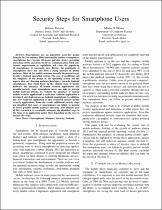JavaScript is disabled for your browser. Some features of this site may not work without it.
- ResearchSpace
- →
- Research Publications/Outputs
- →
- Conference Publications
- →
- View Item
| dc.contributor.author |
Pieterse, Heloise

|
|
| dc.contributor.author |
Olivier, MS

|
|
| dc.date.accessioned | 2014-02-13T08:45:47Z | |
| dc.date.available | 2014-02-13T08:45:47Z | |
| dc.date.issued | 2013-08 | |
| dc.identifier.citation | Pieterse, H and Olivier, M.S. 2013. Security steps for smartphone users. In: Information Security for South Africa, Sandton, South Africa, 14-16 August 2013 | en_US |
| dc.identifier.uri | http://ieeexplore.ieee.org/stamp/stamp.jsp?tp=&arnumber=6641036 | |
| dc.identifier.uri | http://hdl.handle.net/10204/7191 | |
| dc.description | Information Security for South Africa, Sandton, South Africa, 14-16 August 2013. | en_US |
| dc.description.abstract | Smartphones are an important asset for people living in the 21st century.With functionality similar to computers, smartphones have become all-in-one portable devices providing interconnectivity and device-to-device communication. Such continuous improvement in capabilities will cause the popularity of smartphones to constantly rise. Besides the popularity of smartphones there has also been a sharp increase in mobile malware. Most of the mobile malware recently discovered target Google’s Android operating system. The ease of modifying and the simplicity of the design of the operating system are the aspects that are drawing malware developers towards Android smartphones. This study focus on the current state of mobile malware, the adequacy of mobile security applications and possible security steps smartphone users can take to prevent mobile malware attacks. To evaluate the adequacy of current mobile security applications a malicious Android application is developed and deployed on an Android smartphone. In addition, this new Android application is also evaluated against mobile security applications. From the results additional security steps are identified that users of smartphones can follow to prevent or detect possible mobile malware infections. The ultimate goal of this research is to eventually automate the identified steps in the form of an application rather than depending on the user to execute the steps. | en_US |
| dc.language.iso | en | en_US |
| dc.publisher | IEEE Xplore | en_US |
| dc.relation.ispartofseries | Workflow;12024 | |
| dc.subject | Smartphones | en_US |
| dc.subject | Malware | en_US |
| dc.subject | Android | en_US |
| dc.subject | Information security | en_US |
| dc.title | Security steps for smartphone users | en_US |
| dc.type | Conference Presentation | en_US |
| dc.identifier.apacitation | Pieterse, H., & Olivier, M. (2013). Security steps for smartphone users. IEEE Xplore. http://hdl.handle.net/10204/7191 | en_ZA |
| dc.identifier.chicagocitation | Pieterse, Heloise, and MS Olivier. "Security steps for smartphone users." (2013): http://hdl.handle.net/10204/7191 | en_ZA |
| dc.identifier.vancouvercitation | Pieterse H, Olivier M, Security steps for smartphone users; IEEE Xplore; 2013. http://hdl.handle.net/10204/7191 . | en_ZA |
| dc.identifier.ris | TY - Conference Presentation AU - Pieterse, Heloise AU - Olivier, MS AB - Smartphones are an important asset for people living in the 21st century.With functionality similar to computers, smartphones have become all-in-one portable devices providing interconnectivity and device-to-device communication. Such continuous improvement in capabilities will cause the popularity of smartphones to constantly rise. Besides the popularity of smartphones there has also been a sharp increase in mobile malware. Most of the mobile malware recently discovered target Google’s Android operating system. The ease of modifying and the simplicity of the design of the operating system are the aspects that are drawing malware developers towards Android smartphones. This study focus on the current state of mobile malware, the adequacy of mobile security applications and possible security steps smartphone users can take to prevent mobile malware attacks. To evaluate the adequacy of current mobile security applications a malicious Android application is developed and deployed on an Android smartphone. In addition, this new Android application is also evaluated against mobile security applications. From the results additional security steps are identified that users of smartphones can follow to prevent or detect possible mobile malware infections. The ultimate goal of this research is to eventually automate the identified steps in the form of an application rather than depending on the user to execute the steps. DA - 2013-08 DB - ResearchSpace DP - CSIR KW - Smartphones KW - Malware KW - Android KW - Information security LK - https://researchspace.csir.co.za PY - 2013 T1 - Security steps for smartphone users TI - Security steps for smartphone users UR - http://hdl.handle.net/10204/7191 ER - | en_ZA |






